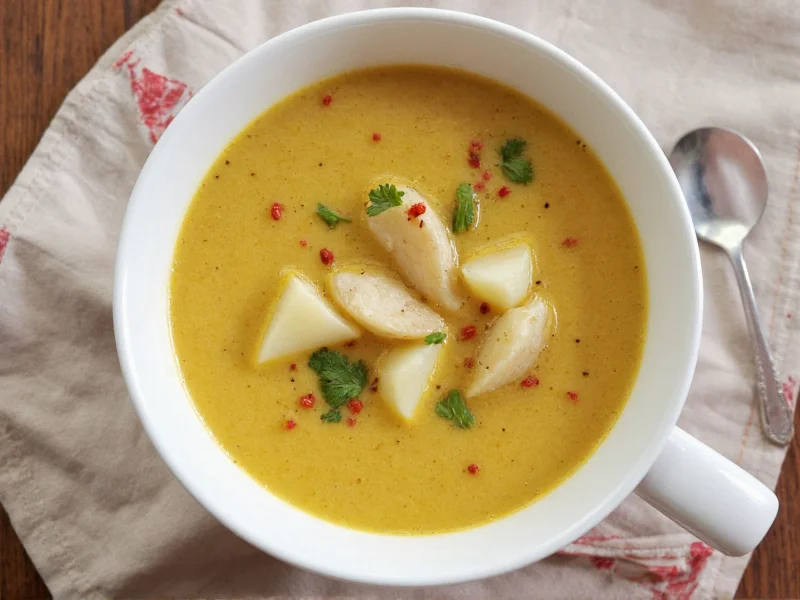The Complete Guide to Parsnips in Soup Making
When exploring how to make parsnip soup from scratch, understanding this versatile root vegetable's unique properties is essential. Parsnips (Pastinaca sativa) resemble pale carrots but offer a distinctive sweet-earthy flavor that intensifies when cooked. Their high natural sugar content makes them particularly well-suited for soups, where slow cooking develops complex caramelized notes without added sweeteners.
Why Parsnips Excel in Soups
Parsnips contain natural pectin and starches that create a creamy texture when blended, eliminating the need for heavy cream in many healthy parsnip soup for immune system recipes. Their flavor profile bridges sweet and savory elements, pairing exceptionally well with warming spices like nutmeg, thyme, and sage. Unlike potatoes, parsnips don't become gluey when overcooked, making them forgiving for beginner soup makers.
| Root Vegetable | Sweetness Level | Texture When Cooked | Best Soup Applications |
|---|---|---|---|
| Parsnips | High | Creamy when blended | Pureed soups, roasted vegetable soups |
| Carrots | Moderate | Firm-chunky | Chunky vegetable soups, broth bases |
| Turnips | Low | Firm | Hearty stews, winter soups |
| Celeriac | Low-Moderate | Creamy | Cream soups, bisques |
Nutritional Powerhouse in Every Spoonful
Understanding the nutritional benefits of parsnip soup reveals why it deserves regular rotation in your meal plan. A single cup of cooked parsnips provides:
- 50% of your daily vitamin C needs
- Significant potassium for heart health
- High fiber content (nearly 7 grams per cup)
- Rich in folate and vitamin K
- Natural prebiotics supporting gut health
Unlike many creamy soups, creamy parsnip soup without dairy achieves its luxurious texture naturally through the vegetable's own properties, making it suitable for various dietary preferences.
Selecting and Preparing Parsnips for Soup
For optimal results in cooking with parsnips for soup, choose medium-sized roots (about 1 inch in diameter) with firm, smooth skin. Larger parsnips often develop a tough, woody core that should be removed before cooking. Younger, smaller parsnips can be used whole.
Preparation steps:
- Scrub thoroughly with a vegetable brush
- Peel if skin appears tough or fibrous
- Remove woody core from larger specimens
- Cut into uniform 1-inch pieces for even cooking
Pro tip: Soak cut parsnips in cold water for 10 minutes before cooking to remove any bitterness, especially in older roots harvested late in the season.
Classic Parsnip Soup Recipes
Master these foundational recipes to explore the versatility of best parsnip soup recipes for winter and beyond.
Simple Traditional Parsnip Soup
This basic recipe showcases parsnips' natural flavor:
- Sauté 1 chopped onion and 2 minced garlic cloves in olive oil
- Add 1.5 lbs chopped parsnips and 4 cups vegetable broth
- Simmer 25-30 minutes until tender
- Blend until smooth, season with salt, pepper, and a pinch of nutmeg
Roasted Parsnip and Apple Soup
For easy parsnip and apple soup recipe with depth:
- Toss 2 lbs parsnip chunks and 2 chopped apples with olive oil, salt, and thyme
- Roast at 400°F (200°C) for 30-35 minutes until caramelized
- Transfer to pot with 4 cups broth and 1 chopped leek
- Simmer 15 minutes, then blend until smooth
- Finish with a squeeze of lemon juice
Flavor Pairings That Elevate Parsnip Soup
Expand your roasted parsnip soup preparation with these complementary ingredients:
| Flavor Category | Recommended Pairings | When to Add |
|---|---|---|
| Herbs | Thyme, sage, rosemary, parsley | During simmering for dried, at end for fresh |
| Spices | Nutmeg, cumin, coriander, smoked paprika | With aromatics at beginning |
| Sweet Elements | Apples, pears, maple syrup, dates | With parsnips for roasting or simmering |
| Savory Boosters | Miso paste, Parmesan rind, smoked salt | Toward end of cooking |
Perfecting Your Soup Texture
Achieving the ideal consistency in how to make parsnip soup from scratch requires attention to cooking technique:
- For silky smooth texture: Cook parsnips until very tender, then blend with an immersion blender. For extra silkiness, strain through a fine-mesh sieve.
- For rustic chunky style: Cut parsnips into small dice and add during the last 15 minutes of cooking.
- For creamy richness without dairy: Add a peeled, chopped potato to the pot along with parsnips.
- For enhanced flavor depth: Roast parsnips before adding to broth for caramelized complexity.
Storage and Reheating Guidelines
Follow these parsnip soup storage and reheating tips to maintain quality:
- Refrigerate in airtight containers for up to 5 days
- Freeze in portion-sized containers for up to 6 months
- Reheat gently over medium-low heat to preserve texture
- Add a splash of broth or water when reheating if soup has thickened
- Stir in fresh herbs after reheating for vibrant flavor
Common Substitutions and Variations
When exploring substitutes for parsnips in soup recipes, consider these alternatives:
- Celeriac: Similar texture with milder flavor (use 1:1 ratio)
- Turnips: More peppery; combine with sweet elements like apples
- Carrots: Sweeter profile; use 75% carrot and 25% parsnip for balanced flavor
- Potatoes: More neutral; requires additional flavor enhancers











 浙公网安备
33010002000092号
浙公网安备
33010002000092号 浙B2-20120091-4
浙B2-20120091-4